Cayr Ariel Wulff's Blog, page 13
April 18, 2012
Blurring the Lines: White Hat or Black Hat?
This past Sunday I was glancing through the pet section of the Plain Dealer classifieds, and I spotted two ads where people were giving their dogs away “Free to a good home”.
Are we all on the same page here as to how dangerous that is? (I’m starting to feel like a broken record, and like I’m preaching to the choir…so I’m not going to go there again…if you are new here, there’s some links below that explain why you should never ever do that.)
I employ a certain type of advocacy for “Free Pet” ads I come across on Craigslist –emailing the advertisers with a list of specific dangers. A quarter of them don’t respond. The other three quarters usually write back that they had no idea about the dangers. That usually opens an email conversation about what other options they have. I always fully expect to get nasty emails in return, but that has never happened.
Until recently we didn’t subscribe to any newspapers, but Dalene got ambushed somewhere last week, and now we are getting the weekend PD and the Sunday Beacon. Hooray. Like I needed another place to check for free pets. I saw the two ads last night and when I got up this morning, before I even had my coffee, I called both of them. One was for a 7-yr old puggle; “moving and he can’t come”. The other was for a 1-yr-old housebroken Kai Ken. “great dog”.
Honestly, the puggle ad should have just read “please come take my 7-year-old dog that I don’t care about and sell it to a laboratory so it can have caustic substances sprayed in its eyes and on its skin” and the Kai ken ad should have read “Got your next bait dog right here. High prey drive, good training dog.” But I pushed down my gut reaction and tucked away my sarcasm and just called to let these people know what kind of danger they were putting their pets in.
In both cases, I got voice mail. Instead of leaving a long message, I simply told each of them that I had seen their ad, and wanted them to know that by offering their pet ‘free’ they were putting the pet in serious danger. I suggested that they go online and google “Pets in Danger on Craigslist” or “No Free Puppies or Kittens” or just the name “Jeffrey Nally” if they wanted to know why.
Later, one of the advertisers returned my call – unfortunately, I missed it, and he got my voice mail. His message said that I didn’t need to call him back (he blocked his number anyway, so I didn’t know which ad was his and couldn’t) that he just wanted to tell me that “it’s none of my business” and it is “people like me who make the world a messed up place”.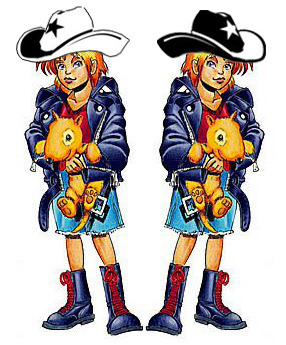
I really wish I hadn’t missed that call…and that I hadn’t used the ads to pick up a pile of dog crap earlier in the day. If I had talked to him, maybe I could have helped him find a better solution than giving his pet away free to some stranger. If he was the puggle guy, I could have recommended a senior shelter. If he was the Kai Ken guy, I could have recommended a breed rescue.
But really, let’s examine this experience for a minute, because it’s never any fun to get a nasty message from someone, and of course, this guy’s angry message pushed all of my buttons.
First, how am *I* the bad guy? I’m not the one that has decided to throw away a pet because it’s suddenly become inconvenient. I’d live under a bridge in a refrigerator box before I’d move somewhere where my five dogs couldn’t come with me. I had called with info, and he had called with insults. And…didn’t he advertise in a public newspaper? Sorry, Buddy, but I’m the public, and I’m a dog advocate who works every day to educate people about animal abuse and cruelty, and that literally makes it my business.
But I couldn’t tell him any of that because he blocked his phone number. And I kind of think that if I’d called him back he wouldn’t have let me get a word in edgewise anyway.
When the person trying to protect the innocent becomes the bad guy because an irresponsible person doesn’t want to actually *think* about what they are doing…then the world really is a messed up place.








April 5, 2012
The Price of Winning
I spent a good part of this morning crying.
Not so much because anything bad happened, but because something pretty good happened….but it didn't happen without a price.
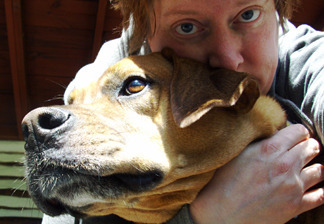 In March of 2011 there was a horrible story of animal abuse in the news. It happened in West Virginia, and it was one of the most shocking things I have ever heard. Moreover, the case was a perfect example why people should never ever offer pets "free to a good home". If you've been following my blog for any length of time, you know that I do my best to educate people as to why offering pets "Free" puts them in deadly danger. If you need a reminder, you can read those blog posts here:
In March of 2011 there was a horrible story of animal abuse in the news. It happened in West Virginia, and it was one of the most shocking things I have ever heard. Moreover, the case was a perfect example why people should never ever offer pets "free to a good home". If you've been following my blog for any length of time, you know that I do my best to educate people as to why offering pets "Free" puts them in deadly danger. If you need a reminder, you can read those blog posts here:
No Free Puppies or Kittens
Pets in Danger on Craigslist
I didn't hear anything about the West Virginia case for months..but then there was an update in January, and when I saw it, I began covering the story for Pet Pardons News. (Hey! did you know I am writing for Pet Pardons News, now?) Pet Pardons  has started a website where they keep people informed about animal cruelty cases, animal welfare laws, pet food recalls…you name it. If it's about pets, we try to cover it.
has started a website where they keep people informed about animal cruelty cases, animal welfare laws, pet food recalls…you name it. If it's about pets, we try to cover it.
The case out of West Virginia is about a young man named Jeffrey Nally. Barely more than a kid, but already he is has proven that he is a clear threat to society. What he did is so brutal, so sick, that I don't even like having his name here on my blog page. Nally obtained 29 "Free" pets from classified ads and ads on Craigslist, and then he tortured and mutilated them and killed them. Most of them were puppies. As if that's not crazy enough, there are details in the story far more bizarre than that. You can read the whole story on Pet Pardons News if you are so inclined.
Alleged Puppy Torturer Appears in Court
Accused 'Free to Good Home' Pet Killer Will Move to Suppress Evidence
"Free To A Good Home" Craigslist Dog Killer Sentenced in West Virginia
During the time I've covered the story, I've spoken with the Hancock Country Prosecutor a number of times. He was very helpful in providing information for my articles, and I could tell when I spoke to him that he was in it to win. He has dogs too, and he loves them.
When the first reports came out that Nally had been sentenced yesterday, I gathered all the info I could, and then I called the Country Prosecutor this morning and had a chat. We talked about all the aspects of the case. Nally had been charged with 29 counts of felony animal cruelty and a couple of other things as well. He ended up taking a plea deal, admitting to 9 counts of animal cruelty and 1 count of illegal possession of a firearm. (he has a prior domestic abuse record). The Judge sentenced him yesterday to 10-45 years in prison.
That's huge. Do you know how significant that is?
In most cases of animal abuse, people get off with ridiculously light sentences. Things like a small fine and community service in an animal shelter. (like that makes sense.) Maybe, once in awhile, they'll get 30 days in jail. So, even though the other 22 charges against him were dropped, Nally still got one of the most severe sentences for animal abuse ever.
It's no small victory.
It wouldn't have been possible without some amazing people. The Animal Legal Defense Fund, the thousands upon thousands of people from around the world who signed petitions, emailed officials and sent letters, the forensic veterinarians who helped build the case, the officers, and the Prosecuting Attorney.
So…I'm back to him. Several times while we discussed the details of the case, I noticed a change in his voice. I finally said to him "I'm getting the feeling from the sound of your voice, that this has been a very disturbing case for you."
There was complete silence on the line. I thought my cell phone had dropped the call. "Did I lose you?" I asked.
His voice, choked with emotion said "No, I'm here.." but he couldn't go on, because this tough prosecutor, this guy who has tried bunches of cases in his career, was crying. And I cried too; for how hard he worked over the past year, how difficult it must have been to see the photographs in evidence, how exhausting it must have been to concentrate on such horrible acts of cruelty for such a length of time, and for the nightmares that I know he will have because of it.
must have been to concentrate on such horrible acts of cruelty for such a length of time, and for the nightmares that I know he will have because of it.
James W. Davis Jr. is a hero in my book.








March 31, 2012
Defining “Run of the Mill”
Last month, Facebook and the ASPCA worked together to put an end to ads for puppy mills on Facebook Marketplace. I wrote an article about it for Pet Pardons News, and while I was researching it, an interesting fact came to my attention.
The ASPCA commissioned a poll that found while most Americans have heard of puppy mills and say they wouldn’t buy a dog that came from one, most Americans also believe that the dogs in pet stores come from legitimate sources. Many people also mistakenly think that anti-puppy mill campaigns are about the puppies.
Think about the word mill for a minute. Two of the definitions of “mill” are
A factory where something is manufactured
To grind, crush, or pulverize.

Warren Cty PA Puppy Mill
photo: Animal Rescue Corps
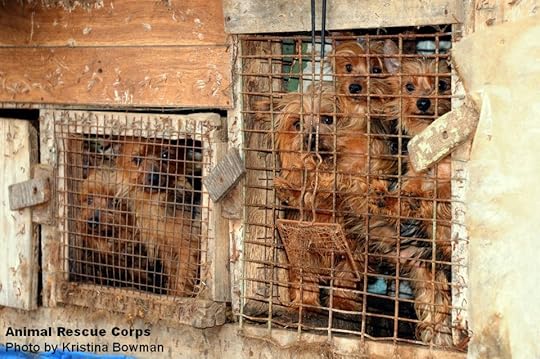
Warren County PA
photo: Animal Rescue Corps
Both of these definitions apply to the places referred to as puppy mills. The purpose of a puppy mill is to produce as many puppies as possible, which are then sold to pet stores, and which are then, in turn, sold to consumers. Like any factory, the owner is in it to make money; which means spending as little as possible on overhead to make a maximum profit. There is a lot wrong with that picture.
The victims are not really the puppies. The puppies get out. They are loveable and cute and the lucky ones will end up in homes where people love them like a family member. But the puppies parents never get out. They live their lives out at the puppy mill in conditions that are no better than a concentration camp.
Spending as little as possible on overhead means that the breeding parents are kept in tiny cages. Sometimes multiple dogs are crammed into a single cage. A cage which has a wire floor so when the dogs urinate and defecate, it falls through the grate. Cages are often stacked on top of each other in overcrowded conditions, so the waste falls through to the cages below. The cages are only big enough to stand up, lie down and bear puppies, and they are unprotected from the heat, the cold and rain. The breeding parents aren’t groomed, are only minimally vetted (if at all), do not receive an ounce of attention or affection, and spend their entire lives in a tiny box where they have to stand on wire. They develop eye infections from the concentration of ammonia from the urine, sometimes to the point of blindness. Their feet become cut and infected from the wire. Sometimes they become so matted their fur catches in the wire and actually hold them to one spot. They never go for a walk, never get to run, never get to curl up in a clean warm bed. They never know the gentle touch of a caring hand. The females are bred every heat cycle so they will be pregnant as many times a year as physically possible – for their entire lives.
That’s where the second definition of mill comes in; because these dogs have their spirits and their bodies ground to dust.
A couple of posts back, I wrote about compassion being a great motivator. In that post I mentioned a scientific finding about dogs; that studies have shown that the average dog has the intellectual and emotional intelligence of a three-year-old child. I think that bears repeating – because these dogs kept as breeding parents, they’re not ‘things’. They are conscious living beings, and they know what is happening to them. Can you for one second, imagine their despair? Their hopelessness? Their loneliness? Their sadness?
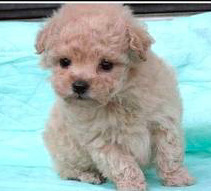
A pet store puppy...
When a person goes into a pet store, and buys that cute puppy they have no idea what has been left behind. They have no idea of the suffering. That’s why it’s so important to cut off the demand for puppy mill puppies by not buying puppies in pet stores, and by not buying anything from a store that sells puppies; because as long as there is money to be made, the cycle will continue. There are an estimated 15,000 puppy mills in the U.S. that produce an estimated 4 million puppies per year.
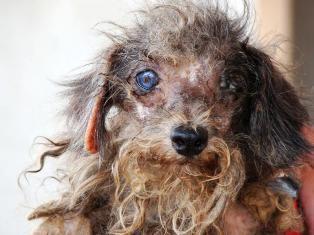
The mother the pet store puppy left behind.
Now that you are armed with that information, what can you do? You do want to do something, don’t you?
Here are some suggestions:
Don’t EVER buy a puppy from a pet store. There are puppies of all breeds in shelters across the country – all in danger of being killed because there aren’t enough homes. You never have to set foot in a shelter – you can find the dog you want online at Petfinders. It doesn’t even matter anymore if the puppy is in a shelter out of state, because there are groups of volunteers that will transport shelter dogs to anywhere in the US.
Spread the word! Share this blog with others, and if someone tells you they are thinking of getting a puppy, tell them why they shouldn’t buy one from a pet store.
Support groups like the HSUS and Animal Rescue Corps (ARC), who work to shut down puppy mills and rescue all of the dogs.
Support legislation to end puppy mills and dog auctions (which are trading venues for puppy millers) In Ohio, the group: Ohio Voters Against Puppy Mills and Dog Auctions has been working tirelessly on a ballot initiative to ban Ohio dog auctions. If there is similar legislation pending in your state, let your representatives know you support it.








Defining "Run of the Mill"
Last month, Facebook and the ASPCA worked together to put an end to ads for puppy mills on Facebook Marketplace. I wrote an article about it for Pet Pardons News, and while I was researching it, an interesting fact came to my attention.
The ASPCA commissioned a poll that found while most Americans have heard of puppy mills and say they wouldn't buy a dog that came from one, most Americans also believe that the dogs in pet stores come from legitimate sources. Many people also mistakenly think that anti-puppy mill campaigns are about the puppies.
Think about the word mill for a minute. Two of the definitions of "mill" are
A factory where something is manufactured
To grind, crush, or pulverize.

Warren Cty PA Puppy Mill
photo: Animal Rescue Corps

Warren County PA
photo: Animal Rescue Corps
Both of these definitions apply to the places referred to as puppy mills. The purpose of a puppy mill is to produce as many puppies as possible, which are then sold to pet stores, and which are then, in turn, sold to consumers. Like any factory, the owner is in it to make money; which means spending as little as possible on overhead to make a maximum profit. There is a lot wrong with that picture.
The victims are not really the puppies. The puppies get out. They are loveable and cute and the lucky ones will end up in homes where people love them like a family member. But the puppies parents never get out. They live their lives out at the puppy mill in conditions that are no better than a concentration camp.
Spending as little as possible on overhead means that the breeding parents are kept in tiny cages. Sometimes multiple dogs are crammed into a single cage. A cage which has a wire floor so when the dogs urinate and defecate, it falls through the grate. Cages are often stacked on top of each other in overcrowded conditions, so the waste falls through to the cages below. The cages are only big enough to stand up, lie down and bear puppies, and they are unprotected from the heat, the cold and rain. The breeding parents aren't groomed, are only minimally vetted (if at all), do not receive an ounce of attention or affection, and spend their entire lives in a tiny box where they have to stand on wire. They develop eye infections from the concentration of ammonia from the urine, sometimes to the point of blindness. Their feet become cut and infected from the wire. Sometimes they become so matted their fur catches in the wire and actually hold them to one spot. They never go for a walk, never get to run, never get to curl up in a clean warm bed. They never know the gentle touch of a caring hand. The females are bred every heat cycle so they will be pregnant as many times a year as physically possible – for their entire lives.
That's where the second definition of mill comes in; because these dogs have their spirits and their bodies ground to dust.
A couple of posts back, I wrote about compassion being a great motivator. In that post I mentioned a scientific finding about dogs; that studies have shown that the average dog has the intellectual and emotional intelligence of a three-year-old child. I think that bears repeating – because these dogs kept as breeding parents, they're not 'things'. They are conscious living beings, and they know what is happening to them. Can you for one second, imagine their despair? Their hopelessness? Their loneliness? Their sadness?

A pet store puppy...
When a person goes into a pet store, and buys that cute puppy they have no idea what has been left behind. They have no idea of the suffering. That's why it's so important to cut off the demand for puppy mill puppies by not buying puppies in pet stores, and by not buying anything from a store that sells puppies; because as long as there is money to be made, the cycle will continue. There are an estimated 15,000 puppy mills in the U.S. that produce an estimated 4 million puppies per year.

The mother the pet store puppy left behind.
Now that you are armed with that information, what can you do? You do want to do something, don't you?
Here are some suggestions:
Don't EVER buy a puppy from a pet store. There are puppies of all breeds in shelters across the country – all in danger of being killed because there aren't enough homes. You never have to set foot in a shelter – you can find the dog you want online at Petfinders. It doesn't even matter anymore if the puppy is in a shelter out of state, because there are groups of volunteers that will transport shelter dogs to anywhere in the US.
Spread the word! Share this blog with others, and if someone tells you they are thinking of getting a puppy, tell them why they shouldn't buy one from a pet store.
Support groups like the HSUS and Animal Rescue Corps (ARC), who work to shut down puppy mills and rescue all of the dogs.
Support legislation to end puppy mills and dog auctions (which are trading venues for puppy millers) In Ohio, the group: Ohio Voters Against Puppy Mills and Dog Auctions has been working tirelessly on a ballot initiative to ban Ohio dog auctions. If there is similar legislation pending in your state, let your representatives know you support it.








March 1, 2012
Have You Used Your Superpowers Today?
A friend on Facebook asked me this week "What do you do all day?" which I am sure was prompted by the fact that I spend way too much time online.
But this simple question from someone I barely know gave me pause, and I thought about it for a couple of hours before I responded. My eventual answer was posted in a Facebook update:
Isn't it obvious? I use my superpowers to fight the forces of evil! 
I know that my answer provided some chuckles for other Facebook friends, who indicated their appreciation by clicking the "like" button…but I was really only partly joking.
Something most people don't know about me is that I am a Fangrrl. I love comic books, have read various titles throughout my life, and would even go as far as to say that one comic series in particular had a HUGE influence on my life. (yes, I know – my inner geek is showing.)
One of the things about comic book heroes is that they have Superpowers. That's what makes them different from the average person. In the comic I have loved for the past 30 years, (Elfquest), the characters' superpowers run the gamut. There are healers, nature shapers, flyers, and telepaths, to name a few. The story's main character, though, doesn't have typical magic. He has a much more subtle superpower: he can accept change, and looks for new ways of doing things.
That might not seem like much…and for most of you, I'm sure that you are thinking that it doesn't even sound like much of a superpower at all. I am not going to debate that. I just want you to consider that as you think about yourself for a moment and see if you can figure out what your own superpowers are.
My point is that everybody has things they are good at. Everybody has strengths. Whatever it is that you are good at – THAT is your superpower. Just like in the comics, should you decide to use it, you will be able to achieve heroic ends.
I challenge you to define your own superpowers, and determine whether or not you are using them to fight the forces of evil…or whether you have gone to the dark side by letting them lie dormant.
Here are my powers that are super:
Spelling
Understanding
Purpose
Empathy
Research
…and here's what I use them to do:
Petition
Organize
Write
Educate
Rescue
…and the things they help me fight:
Fear
Ignorance
Greed
Hatred
Torture
Exploitation
Violence
Inhumanity
Lawlessness
Remember, having superpowers comes with a cost. Most super heroes have secret identities (check), no social life (check), and major super villain problems (check)!
And once you know you have superpowers, the knowledge comes with the great responsibility of using them to save the world.
Tell me in comments what your superpowers are , and what you are doing with them! And please, use them for good, not evil.








February 13, 2012
Taco and the Zen of Hopeful Optimism
I have always considered myself an optimist. Not a rose colored glasses Pollyanna, by any means, but someone who gives people the benefit of the doubt and expects that eventually good will win out over evil.
This has often been a personal outlook at direct odds with my partner of 27 years, who sees the world as a dark and malevolent place where danger and misfortune lurk around every corner. Ironically, she does not consider herself a pessimist, even though her perception encompasses the first two definitions of the word 'pessimism' on dictionary.com.
Lately, perhaps as a result of the constant barrage of apathy over empathy, and cruelty over compassion that I encounter daily in my work of animal advocacy, I have found my sense of optimism flagging. It's hard to stay positive when the innocent continue to suffer and it feels like the bad guys are winning.
I've been thinking a lot about optimism lately and I'd like to introduce you to the reason why.
By the age of three, she had already been discarded by two previous owners. When she came to live with us, in this; her third home, she had baggage. She was beset with insecurities. She has had to find her place in a constantly shifting pack of rescued pets, where she has learned to fly under the radar. She is now eleven years old with a bum knee and a skin allergy, and she is the target of IQ-challenged Rocket-Boy's exuberant extremely-loud-and-incredibly-close barking campaign to make her deaf.
All things considered: Taco is the living embodiment of hopeful optimism.
Whenever one of us heads toward the kitchen, Taco is right on our heels. She knows that food is handled in that room and that sometimes it falls on the floor. She has always been on hand to clean up errant cookie crumbs, pieces of chopped vegetable, the occasional piece of fat, spilled milk, and bits of cereal.
If we glance her way, she makes eye contact and wags her tail happily. The wider we smile, the more vigorously she wags her tail. The sparkle in her eye belies her eternal hope: that one day, in the kitchen, someone will drop an entire steak.
We can all learn a thing or two from her attitude. When we lose a job, or a friend; as we struggle with pain or illness or just the next idiot in a long parade of puzzling acquaintances, we should remember to remain hopefully optimistic about what's through the next door.
There might be a potato chip, or a sugary froot loop; a dollop of peanut butter or a piece of carrot. A gift; a friendship, a new opportunity; the possibilities are endless!

(I wanted to capture Taco's optimism on video, but the instant a camera is pointed at her she becomes the most miserably depressed dog in the universe.)








January 23, 2012
Change, not Chains
It's that time of year again. It's almost Valentine's Day and that means it's time for the annual Dogs Deserve Better valentine campaign. Dogs Deserve Better is a 501c3 non-profit advocacy group devoted to rescuing chained, penned and neglected dogs and advocating to pass anti-tethering animal welfare legislation. 
Last year when I shared the valentine campaign on my Facebook page, one of my nieces thought it was the most ridiculous thing she'd ever heard of. Also during the past year, a cousin reading my blog asked "Rescuing chained dogs? Like, dogs chained in a yard?"
Two years ago, I didn't know much about this movement, but I've spent some time educating myself since then: so let me tell you what I've learned.
Dogs are social creatures. In nature, they live in packs with a social hierarchy. When we domesticated dogs and took them into our homes, we essentially became their 'pack'. As this relationship evolved, we made a pact with them: we will provide food, water and shelter. We will be your "pack" and you will help us hunt and will protect us.
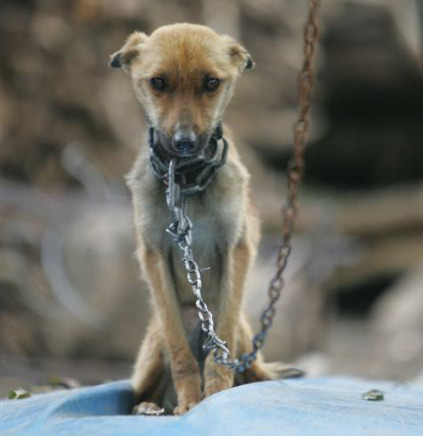 Dogs kept their end of the bargain, and did so much more: they became companions, confidantes, protectors, therapy dogs, search and rescue dogs, drug sniffers, police dogs, trackers, hunters, and entertainers. They want nothing more than to please us. But at least half of humanity has failed them. Many dogs do not even receive basic vet care. Some cannot rely on their owners for regular feedings. A good many of them are chained outdoors, more often than not without adequate shelter or water. Many of them die on the end of a chain, starved, sick, lonely and forgotten. More die that way than you would care to know. Some of them hang themselves when their chains get caught on trees or fences.
Dogs kept their end of the bargain, and did so much more: they became companions, confidantes, protectors, therapy dogs, search and rescue dogs, drug sniffers, police dogs, trackers, hunters, and entertainers. They want nothing more than to please us. But at least half of humanity has failed them. Many dogs do not even receive basic vet care. Some cannot rely on their owners for regular feedings. A good many of them are chained outdoors, more often than not without adequate shelter or water. Many of them die on the end of a chain, starved, sick, lonely and forgotten. More die that way than you would care to know. Some of them hang themselves when their chains get caught on trees or fences.
Close your eyes and imagine for a minute what life is like for a dog on a chain. They wear a chain around their neck, sometimes without a collar – sometimes with a collar that is so tight that it becomes embedded in their neck.
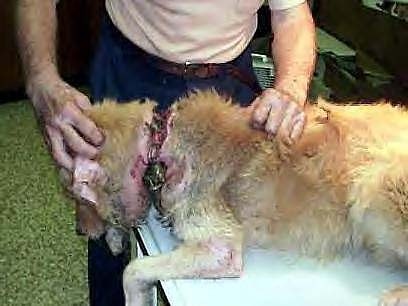
This dog was chained with a collar so tight that it became embedded.
Sometimes the chain is so heavy, they can barely move around. Sometimes the chain is so short, they cannot reach food or water or shade and they are forced to stand and lie in their own waste. They are outside in all kinds of weather – rain, snow, blistering sun. Worst of all, they are alone. They may see their people and other people and animals coming and going, but they are tethered to one spot. Alone. Unnoticed. Unable to interact. Aching for a gentle hand or kind word. Remember how I told you they are social animals? Tethering is like solitary confinement – and for what crime? For being a dog.
Chained dogs are not socialized the way they need to be, and they are often fearful and protective of their territory. They defend what they have, even if it's an empty dish and a four foot circle of dirt. Chained dogs account for most of the dog bites in the US each year, because being unsocialized makes them much more likely to be aggressive. It's no wonder they resort to barking and digging. They are bored out of their minds.
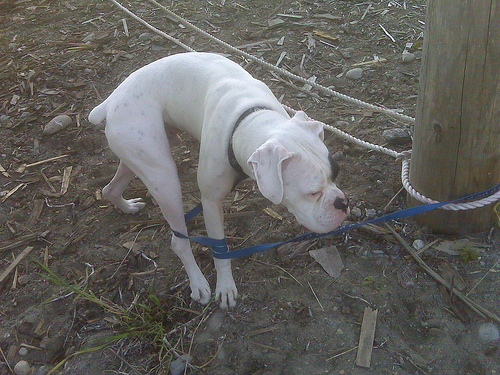
Who is going to untangle him? Some dogs lose legs this way.
Chaining a dog is inhumane. Dogs are made to run and play and socialize. Even those who are fed and watered regularly…even those who can crawl out of the weather under the porch or into a flimsy doghouse…even those dogs need love and attention for their basic well being.
All around the country, people are beginning to understand these basic tenets. Laws are beginning to change that limit the amount of time a dog can be tethered, and under what conditions. Cleveland City Council is currently considering an ordinance that would restrict the tethering of dogs in the city to no more than three hours a day, and only under certain conditions. (read more about that here.)
So, back to valentines…
Dogs Deserve Better hopes to send 18,000 valentines to owners of chained, penned and neglected dogs this year. The valentines come from the dogs chained in their yards. They are meant to remind the dog's caretakers that they are failing. They are not living up to their end of the bargain. The valentines are accompanied by educational brochures about tethering and coupons for food or treats.
DDB needs your help to reach their goal. They need people to make valentines, to tell them the addresses where dogs are chained, and to donate postage. February 5th is the deadline.You can see some samples of valentines from previous years on their website.
Send your valentines and postage to: Dogs Deserve Better – 1915 Moonlight Rd., Smithfield, VA 23430.
Use the form on their website to report addresses (you will remain anonymous). Or email the information to: info@dogsdeservebetter.org

Many dogs starve to death on the end of a chain.
Call Cleveland City Council at 216-664-2840 and tell them that you support the anti-tethering ordinance.
Dogs deserve so much better.








January 8, 2012
Will The Real Dog Please Stand Up?
If you have ever lost a dog or cat that by your estimation was the most unique and remarkable of all companion animals, then you may understand the allure of wanting to clone that pet. It's a romantic and enticing concept; to resurrect a pet that has died. But that's a common mistake that people make when they think of cloning.

Waldo's petfinder doppelgangers. Which one is he?
I'll admit, Dalene and I talked about cloning Dillon when we heard that the technology had arrived…but boy, am I ever glad we didn't try to bring that to fruition. Think about it for a moment…there's always that one, remarkably special pet that will break your heart when he/she dies. That one-in-a-million pet. A clone will be a genetic reproduction – not your beloved pet resurrected.
Even putting aside the question of whether or not dogs have souls, (I personally think they do), in order to recreate your beloved pet into not only a physical replica, but one with a similar personality, you'd have to recreate every event in the pet's life that shaped him into his unique self. Animals are as much a product of their experiences as humans are. How would you know which were the formative experiences, and would you really want to recreate them ? Even the bad ones?

Rocket Boy's petfinder doppelganger
I just finished reading the book Dog, Inc. by John Woestendiek. It is a non-fiction account of the advent of the pet cloning industry, and it is extremely disturbing. Woestendiek doesn't make any moral judgments in the book, but it's impossible to read it without considering all the implications.
When four million pets are put to death in shelters every year, I question the ethics of breeding – so cloning seems above and beyond that; the most reprehensible and irresponsible action a pet lover can take.
Consider some of the facts that Woestendiek brings to light:

Maria's pet pardons doppelganger.
At the beginning, in order to get a successful clone, scientists had to harvest eggs from as many as 115 dogs. After they re-nucleated the eggs, it resulted in 1,095 reconstructed embryos, which were then transplanted into 123 surrogate dogs. Out of these, three were viable pregnancies, bearing two live births. One died several weeks later. Although this procedure has been "perfected" – now taking "only" somewhere around a dozen dogs to create a clone of a pet…the procedure often results in multiple clones. So suddenly, you don't have one clone of your pet, but 2 or 3 or 5.
And what about those extra clones and the dogs it took to make them? Pet cloning is only being done in South Korea, and for a very good reason: they don't have the animal welfare laws that we have here in the US. The dogs they use for harvesting eggs and implanting embryos come from farms where dogs are raised for the meat trade…and when the scientists are finished with them, they go right back there. The extra clones end up living their lives out in cages in the laboratory where they can be studied.
How does any of this honor a special pet?
Plus, the clone isn't going to live forever, and may in fact have a shorter life span than the original pet.
If this isn't the pinnacle of human hubris and disregard for life, I don't know what is.

Taco's petfinder doppelgangers. Can you find her?
Maybe it would be more prudent to memorialize that special pet in ink.

via Modern Dog Magazine








December 27, 2011
The Only Motivation You Need is Compassion
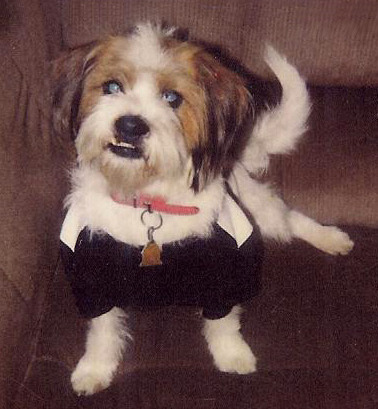
Troll said he wanted to be "just like the silver dog"
Lately, I've noticed more and more animal rescuers and crossposters on Facebook making noise about some of the graphic photos of animal abuse being shared. I wrote a little bit about the issue here Up on the Woof two posts ago.
In spite of that post, somebody did it to me again on December 7; sharing a video of a case out of Brazil. It's made the rounds, so if you are a rescuer with a presence on Facebook, chances are you've seen it. The description was written in Portuguese, which I do not speak, so I clicked on it. I watched about 15 seconds of it before I'd reached my limit.
All year, I've been doing my best to advocate for animals. Some of the stories have been truly horrible. I guess that all year, every time I read about a case or saw a photo of extreme abuse I was like a sponge filling up with water. After 15 seconds into the video from Brazil, I reached my saturation point – I couldn't absorb one more cruel thing. Then it was like a little safety switch went off shutting me down emotionally before anything shorted out.
For a moment, I was very very angry. I typed a comment on the "friend's" share (under the "sharing" "sharing" comments) that basically said "Don't share this, report it!" Then I posted a question to all rescuers on my own wall:
"I would like somebody to tell me what the point is of sharing photographs of horrific animal abuse that has taken place last week, last month or last year in a foreign country? Tell me, please. Because if I see any more of them, I'm going to have to go back on meds."
Only one person answered me, and it went something like this: "I think it's important to remember the abuse. In my world, it somehow honors the memory of the poor creature(s) that have died… or not. Some quickly put the horror out of their minds so as not to deal with the pain & I want it fresh so I will keep fighting."

Dillon the "silver dog". Told me to quit complaining about his bark, because it didn't intimidate anyone.
In other words, the person who had replied used the posts to stoke her anger, and her anger kept her motivated.
Anger doesn't motivate me – anger makes me feel washed out and exhausted and depressed, and therefore is not a useful emotion for me. Ten seconds of that video went beyond angering me. I've kind of been floundering since seeing those ten seconds…spending less and less time on Facebook, and therefore, not advocating as much as I could be.
It's Compassion that motivates me, and I don't need to be reminded of what lengths people will go to to hurt animals in order for me to feel that compassion. I feel it just seeing their beautiful eyes peering out at me from behind the bars of the shelters they are in. I feel it when I see them hanging their heads because they've lost hope. And when I hear their simple stories of being left behind; of being discarded; of being betrayed by the people they'd die to protect – I feel it.
I had a life-changing experience in 1989. That was the year that my lifemate and I took our four dogs to see an animal communicator. That was the day my whole perspective on animals changed, because that was the day I realized just how much they understand; just how deeply they feel; and just how individual and special each one of them is. That was the day I realized that they had hopes and goals.
Studies have shown that the average dog has the intellectual and emotional intelligence of a three-year-old child. Think about that for just a minute. Can you grasp the profundity of

Taco wanted to know "What is going to happen to me?" because we are her third home and she was worried that we were going to dump her, too.
that? Try to imagine the confusion and suffering of a three-year-old child in a kennel; or chained out in a yard alone with no food, water or shelter from the elements; or abandoned in a foreclosed house. Do you need any other reason to be motivated to help them but that they are sentient and they are innocent? Aren't those images motivating enough without seeing the graphic violence?
I am so very, very tired. Saturated by the level and quantity of the cruelty I've seen this year. I just want to help the animals I can help without being terrorized with graphic images that will haunt me forever.








December 14, 2011
Out to Lunch — Up on the Woof
I don't know how almost a whole month has passed since my last post here Up On The Woof. How is that possible?
I apologize for not being more present here. The good news is that I've been insanely busy. I was recently offered a national column on Examiner.com. My local column: Cleveland Pets Examiner, has been demanding enough on its own, because there have been a million pet events in the greater Cleveland area in preparation for the holiday and the end of the year. Then there's Examiner's America Inspired contest…
Last week, I entered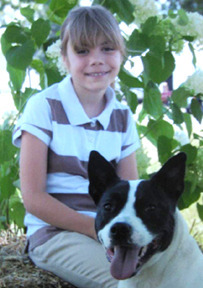 an article in the contest nominating Karlie Smick as Outstanding Youth. Karlie is the extraordinary 9-year-old girl from Columbia Station who runs an annual pet food drive/fundraiser for local animal shelters, called Karlie's Cause.
an article in the contest nominating Karlie Smick as Outstanding Youth. Karlie is the extraordinary 9-year-old girl from Columbia Station who runs an annual pet food drive/fundraiser for local animal shelters, called Karlie's Cause.
Karlie Smick and Rogue
If Karlie's story makes it into the finals, she and I will need your votes during the month of January! Karlie has already committed to donating half of her winnings to Karlie's Cause, and if we make it to the finals, I will finally be able to repay Valley Save-a-Pet for Waldo's double-knee surgeries in 2010. The sooner I can repay them, the more funds they will have to help other pet owners in need.
My new national column is National Animal Books Examiner, devoted to reviewing animal-themed books and their authors. Being a dogaholic, I naturally read a lot of animal themed books, so this column seemed like a no-brainer for me…except now with two columns to write I don't seem to have nearly enough time to read! I've managed to make it through a handful of wonderful books though, and post reviews for them. Of those, I just can't stop thinking about Hannah's Dream, by Diane Hammond, which turned out to be a real gem.
If you haven't checked out either of my columns, consider yourself officially invited to do so. I hope you'll stop by there often, comment, subscribe and share. My success on Examiner depends on how many people stop by my column, so I hope you'll find the content there interesting enough to make it a habit.
In between all that read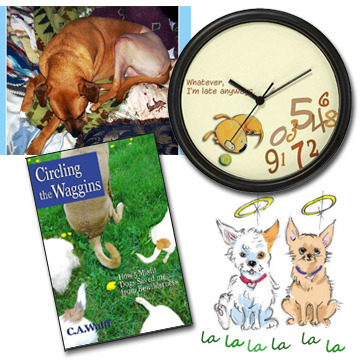 ing and writing, I organized two online fundraisers for Ashley Owen Hill's Lucky Dog Rescue in Meridian Mississippi. The art auction was very successful thanks to the kindness of the artists who participated and the astounding generosity of the bidders. The book raffle fundraiser has been moderately successful, but has gone on hiatus now until January 1st, and then it will start up again with six to eight more weeks of books to be raffled. Check out the yelodoggie/LDR raffle web page after January 1 to see what great books are being offered.
ing and writing, I organized two online fundraisers for Ashley Owen Hill's Lucky Dog Rescue in Meridian Mississippi. The art auction was very successful thanks to the kindness of the artists who participated and the astounding generosity of the bidders. The book raffle fundraiser has been moderately successful, but has gone on hiatus now until January 1st, and then it will start up again with six to eight more weeks of books to be raffled. Check out the yelodoggie/LDR raffle web page after January 1 to see what great books are being offered.
Somewhere in between all that stuff I had to squeeze in the design and production of our annual holiday greeting card, create some Yelodoggie designs for new items in the Yelodoggie Café Press store, and knock a few queries out in an attempt to interest a literary agent in the manuscript for my second book Circling the Waggins: How Five Misfit Dogs Saved Me From Bewilderness.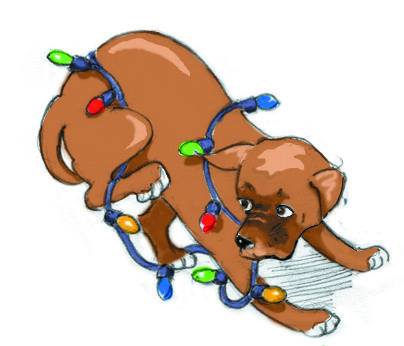
I guess that explains how I never noticed all that time flying by.
Before I lose track of the next two weeks, I want to wish you a very Happy Holiday Season, and I hope you will stick with me Up on the Woof in the coming year.












